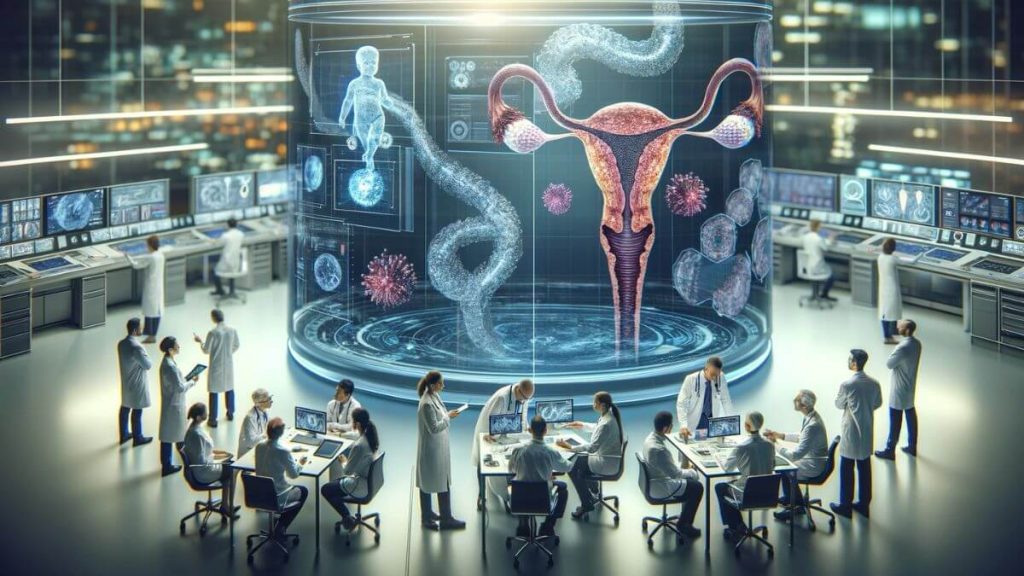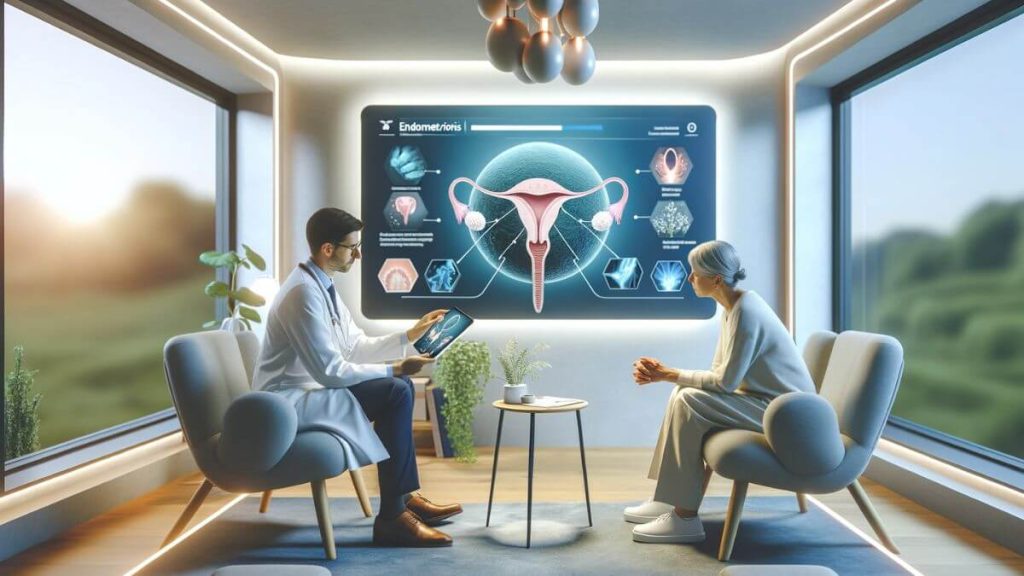Endometriosis Research and Treatment Updates
Welcome to the world of endometriosis research and treatment updates! I’m excited to share with you the latest updates and advancements in the field.
Endometriosis research and treatment have advanced, focusing on minimally invasive diagnostic techniques, hormone therapy, and immunomodulatory treatments. Recent studies explore genetic links and stem cell therapy, offering hope for more effective and personalized management options.
- Why Endometriosis Research and Treatment Updates?
- Potential Breakthrough Drug to Begin Clinical Trials Soon
- New Research Explores Cannabis as a Treatment for Endometriosis
- Drug Candidate for Endometriosis
- Managing Endometriosis: The Benefits of Pelvic Floor Therapy
- Understanding the Role of Neurotrophins in Endometriosis Pain
- Magnetic Hyperthermia: A Promising Alternative for Endometriosis Treatment
- The Impact of Endometriosis on Women's Health and the Need for Research Funding
- The Future of Endometriosis Research and Treatment
- Conclusion on Endometriosis Research and Treatment Updates
- Source Links
Why Endometriosis Research and Treatment Updates?
As someone who has personally experienced the challenges of supporting someone living with endometriosis, I understand the importance of staying informed about the latest breakthroughs and management options.
Endometriosis affects millions of women worldwide, causing debilitating symptoms and impacting fertility. The economic burden of endometriosis is staggering, yet research funding has been historically inadequate. However, the tides are turning, and progress is being made.
In this article, we will explore new treatment options that are on the horizon, such as a potential breakthrough drug that shows promise as a non-hormonal and non-surgical option. We will also dive into the research surrounding medical cannabis as a potential pain relief option and other innovative therapies like pelvic floor therapy and targeted nerve growth inhibitors.
But it doesn’t stop there. We will discuss the need for increased research funding and how it can pave the way for personalized medicine and improved care for endometriosis patients. The future holds exciting possibilities, and I can’t wait to share them with you.
If you want to learn more about endometriosis, I wrote an “Endo-Tool, Endometriosis for Men” e-Book.
You can get the 1st Chapter of the e-Book for FREE, and if you like it, you’ll get a Whopping 33% Discount on the Whole Book, plus discounts on other helpful tools. You have nothing to lose but a lot to gain!
The first chapter alone contains all the comprehensive medical knowledge about endometriosis, including:
- What is endometriosis?
- What are the symptoms?
- What causes endometriosis?
- What does endometriosis look like?
- What are the stages?
- What are the types?
- What is adenomyosis and how is it related to endometriosis?
- Why do some women develop severe endo and others don’t?
- Does endometriosis cause infertility?
- How is endometriosis diagnosed?
- Do types and stages affect the treatment?
- Recurrence of endometriosis after excision surgery.
FREE Chapter of “Endo-Tool”
Endometriosis e-Book for Men

Potential Breakthrough Drug to Begin Clinical Trials Soon
A promising new treatment option for endometriosis is on the horizon with the development of a potential breakthrough drug called dichloroacetate. This non-hormonal and non-surgical drug has shown great promise in reducing the size of endometriosis lesions, offering hope for improved management of the condition. Clinical trials for dichloroacetate are set to begin soon, representing a significant step forward in the search for new treatment options for endometriosis.
Researchers from the University of Edinburgh have found that dichloroacetate can effectively reduce lactate production in endometriosis lesions. Lactate production is associated with the development and persistence of endometriosis. By targeting this process, dichloroacetate has the potential to not only alleviate symptoms but also address the underlying cause of the condition.
The upcoming clinical trials are made possible by funding awarded by Wellbeing of Women and the Scottish Government. These trials will further evaluate the efficacy and safety of dichloroacetate, bringing us one step closer to a non-hormonal and non-surgical treatment option for endometriosis.
If successful, this potential breakthrough drug could revolutionize the way we manage and treat endometriosis, offering hope for millions of women worldwide.
Potential Breakthrough Drug Clinical Trials
| Research Institution | University of Edinburgh |
|---|---|
| Funding Sources | Wellbeing of Women, Scottish Government |
| Treatment | Dichloroacetate |
| Trial Objectives | Evaluate efficacy and safety of dichloroacetate |

New Research Explores Cannabis as a Treatment for Endometriosis
As the search for effective endometriosis treatments continues, researchers are turning to medical cannabis as a potential option. A clinical trial conducted by Western Sydney University in Australia aims to investigate the benefits of using cannabis for relieving endometriosis-related pain. The trial will evaluate the effects of two different forms of medicinal cannabis, cannabidiol (CBD) isolate and a balanced oil containing both CBD and delta-9-tetrahydrocannabinol (THC).
Prior studies have shown that cannabis can regulate inflammation and immune function through its interaction with the endocannabinoid system. By targeting the endocannabinoid system, cannabis has the potential to provide pain relief and improve symptoms associated with endometriosis.
This research trial will offer valuable insights into the efficacy and safety of using cannabis as a treatment option for managing endometriosis-related pain.
Understanding the Potential of Cannabis for Endometriosis Treatment
The clinical trial conducted by Western Sydney University will shed light on the potential benefits of using cannabis as a treatment for endometriosis. By exploring the effects of both CBD isolate and a balanced CBD-THC oil, researchers will gather data on the efficacy and safety of these cannabis formulations in relieving endometriosis-related pain.
This research is based on previous evidence suggesting that cannabis can regulate inflammation and immune function, which are factors involved in endometriosis.
By targeting the endocannabinoid system, cannabis may provide pain relief and address the symptoms experienced by women with endometriosis. The outcome of this trial could lead to the development of alternative treatment options for managing endometriosis-related pain.
Drug Candidate for Endometriosis
A groundbreaking drug candidate developed by FimmCyte has shown promising results in animal studies, surpassing the efficacy of the current standard of care for endometriosis treatment. This non-hormonal therapy specifically targets proteins that are overexpressed on endometriotic cells, leading to the clearance of these cells by the immune system. The higher efficacy demonstrated in animal studies offers hope for a safe and effective treatment option for women with endometriosis.
Unlike the current standard of care, which relies on gonadotropin-releasing hormone (GnRH) antagonists, FimmCyte’s drug candidate presents a novel approach to treating endometriosis. By targeting the proteins associated with endometriotic cells, this therapy has the potential to provide better outcomes and improve the quality of life for women living with this condition.
Potential Benefits of FimmCyte’s Drug Candidate
- Higher efficacy compared to current treatment options
- Non-hormonal therapy
- Specifically targets overexpressed proteins in endometriotic cells
- Promotes clearance of endometriotic cells by the immune system
While further research and clinical trials are necessary to confirm the efficacy and safety of FimmCyte’s drug candidate in human patients, these initial animal study results are promising. If successful, this non-hormonal therapy could revolutionize the treatment of endometriosis and provide a much-needed alternative for women who do not respond well to current treatment options.
| Treatment | Efficacy | Method |
|---|---|---|
| Current standard of care: GnRH antagonists | Variable | Hormonal therapy |
| FimmCyte’s drug candidate | Higher efficacy | Non-hormonal therapy |

Managing Endometriosis: The Benefits of Pelvic Floor Therapy
When it comes to managing endometriosis, there is growing evidence supporting the benefits of pelvic floor therapy. This non-surgical approach, also known as physiotherapy, offers a promising avenue for pain management in women with endometriosis-induced chronic pelvic pain.
Research studies have shown that incorporating pelvic floor therapy into the lifestyle of patients with deeply infiltrative endometriosis can lead to improved superficial dyspareunia, increased levator hiatal area, and better management of chronic pelvic pain. These therapeutic interventions, which may include physiotherapy, kinesiotherapy, physical therapy, and balneology, have been found to be effective in alleviating endometriosis-related pain.
With approximately 80% of chronic pelvic pain caused by endometriosis, pelvic floor therapy provides a valuable tool for pain management in these patients.
By addressing the underlying musculoskeletal dysfunction and promoting pelvic floor strength and coordination, this therapy can significantly improve the quality of life for women with endometriosis. It offers a holistic approach to pain management and complements other treatment options, such as medication and surgery.
The Role of Pelvic Floor Therapy in Endometriosis Management
Pelvic floor therapy aims to address the musculoskeletal imbalances and dysfunction that can contribute to endometriosis-induced pain. By targeting the muscles, ligaments, and connective tissues in the pelvic region, this therapy aims to improve muscle tone, reduce muscle tension, and enhance overall pelvic floor function.
Understanding the Role of Neurotrophins in Endometriosis Pain
Endometriosis pain is a debilitating symptom that affects millions of women worldwide. Recent research from the University at Buffalo and the University of Michigan has shed light on the potential role of neurotrophins in the development and persistence of endometriosis pain. Neurotrophins are proteins that stimulate the growth and migration of neurons, and excessive expression of these proteins in endometriosis lesions may contribute to the high density of nerves found in these tissues.
By understanding the molecular pathways involved in endometriosis pain, researchers can explore new strategies for targeted therapy. Blocking nerve growth and pain transmission in endometriosis could provide significant relief for patients suffering from this chronic condition. Identifying both peripheral and central generators of pain in endometriosis is crucial for developing pharmacological approaches that specifically target the underlying mechanisms of pain.
The Potential for Targeted Therapies
The study’s findings have opened up new avenues for potential targeted therapies in the management of endometriosis pain. By inhibiting the excessive expression of neurotrophins, researchers can potentially reduce nerve density and alleviate pain symptoms. This approach could complement existing treatment options and provide a more comprehensive and personalized approach to managing endometriosis.
Targeted therapies that specifically address the neurotrophin-mediated pathways of pain could revolutionize the way endometriosis is treated. These therapies have the potential to provide long-lasting relief and improve the quality of life for women living with the condition.
Continued research in this field will be essential for the development of effective and safe targeted therapies for endometriosis pain.
Overall, understanding the role of neurotrophins in endometriosis pain is a promising area of research that holds the potential for significant advancements in the treatment of this condition. By targeting the underlying mechanisms of pain, researchers can develop more effective and personalized therapies that provide long-lasting relief for women suffering from endometriosis.
| Endometriosis Pain | Neurotrophins | Targeted Therapy |
|---|---|---|
| Chronic and debilitating symptom | Proteins that stimulate neuron growth | Approach that inhibits neurotrophin expression |
| Excessive nerve density in lesions | Contribute to nerve growth in endometriosis | Reduction of nerve density and pain relief |
| Current treatment options may not provide sufficient pain relief | Potential target for therapeutic intervention | Improved management of endometriosis pain |

Magnetic Hyperthermia: A Promising Alternative for Endometriosis Treatment
When it comes to treating endometriosis, surgery has been a common approach for removing the disease-causing tissue. However, a mouse study conducted by NIH-funded researchers has shed light on a potential alternative – magnetic hyperthermia. This innovative therapy utilizes heat generated by magnetic nanoparticles to effectively remove endometriosis lesions without the need for surgery.
During the study, hexagon-shaped magnetic nanoparticles were targeted specifically to endometriosis tissue. These nanoparticles accumulated in the lesions and, when exposed to an alternating magnetic field, effectively removed the tissue. The technique demonstrated both safety and efficiency, offering promising results for the development of non-surgical treatment options for endometriosis.
With the potential to provide a less invasive approach, magnetic hyperthermia could revolutionize endometriosis treatment. By eliminating the need for surgery, this nanoparticle-mediated therapy offers a more patient-friendly option for the removal of endometriosis tissue.
Not only does this reduce the physical trauma associated with surgery, but it also diminishes the overall recovery time, allowing patients to resume their normal lives more quickly.
As research in the field of magnetic hyperthermia expands, the potential for this therapy in endometriosis treatment becomes increasingly evident. While further studies are needed to fully establish its safety, efficacy, and long-term outcomes, the preliminary results are encouraging.
With continued research and development, magnetic hyperthermia could emerge as a game-changing approach for managing endometriosis, offering an alternative to traditional surgical interventions.
| Magnetic Hyperthermia | Surgical Treatment | |
|---|---|---|
| Procedure | Non-surgical | Invasive surgery |
| Recovery Time | Less time required | Extended recovery period |
| Pain | Minimal discomfort | Potential for post-operative pain |
| Scarring | No visible scars | Potential for visible scars |
| Efficacy | Promising results | Varies depending on individual cases |

The Impact of Endometriosis on Women’s Health and the Need for Research Funding
Endometriosis is a debilitating condition that significantly affects women’s health and well-being. It is estimated that approximately 190 million women and girls worldwide suffer from this condition, which is characterized by the growth of tissue similar to the uterine lining outside the uterus. Endometriosis can cause severe pelvic pain, heavy menstrual flow, and fertility issues, impacting every aspect of a woman’s life.
Unfortunately, the economic cost of endometriosis cannot be overlooked. In the United States alone, the financial burden of this condition ranges from $78 to $120 billion annually. Despite its prevalence and impact, endometriosis research has been chronically underfunded, leading to significant delays in diagnosis and limited treatment options. On average, women wait eight years for a reliable diagnosis, often requiring invasive surgery for confirmation.
The chronic underfunding of endometriosis research is a critical issue that needs urgent attention. Diseases like diabetes and breast cancer receive significantly more research funding, despite endometriosis affecting a similar number of women.
By investing in research and increasing funding, we can gain a better understanding of the underlying mechanisms of endometriosis, develop more effective diagnostic methods, and explore innovative treatment options.
It is crucial to prioritize women’s health and allocate the necessary resources to address this urgent challenge.
The Future of Endometriosis Research and Treatment
As we look to the future of endometriosis research and treatment, there is great potential for advancements that will significantly improve the lives of women with this condition. Ongoing research studies and clinical trials are exploring new therapeutic targets and treatment options, offering hope for more effective and individualized care.
One of the key areas of focus in endometriosis research is personalized medicine. By understanding the unique biological characteristics of each patient’s endometriosis, researchers can develop targeted therapies that address specific underlying factors. This personalized approach has the potential to provide more tailored and effective treatment options, improving symptom management and overall outcomes.
In order to fully unlock the potential of personalized medicine and other treatment advancements, increased research funding is crucial. Currently, endometriosis research is chronically underfunded compared to other diseases of similar prevalence. By investing in research, we can accelerate the development of innovative therapies and improve our understanding of this complex condition.
Advancements in Endometriosis Research and Treatment
With continued research and the development of innovative therapies, the future of endometriosis care is promising. By prioritizing research funding and supporting the advancement of personalized medicine and targeted therapies, we can make significant strides in improving the lives and outcomes of women living with endometriosis.
Table: Overview of recent advancements in endometriosis research and treatment
| Advancements | Description |
|---|---|
| New treatment options | Promising non-hormonal and non-surgical treatment options, such as the potential breakthrough drug dichloroacetate and magnetic hyperthermia, offer alternatives to traditional approaches. |
| Therapeutic targets | Targeting specific biological pathways, such as the gut microbiome and the endocannabinoid system, provides opportunities for more effective and individualized treatment approaches. |
| Personalized medicine | Understanding the unique characteristics of each patient’s endometriosis allows for tailored treatment plans and improved symptom management. |

Conclusion on Endometriosis Research and Treatment Updates
As we conclude this article on endometriosis research and treatment, it is evident that there is hope for brighter days ahead for patients with this condition. The ongoing advancements in medical science and the diligent efforts of researchers and healthcare professionals are paving the way for improved care and patient outcomes.
One of the key pillars of this progress is the development of non-hormonal and non-surgical treatment options. Breakthroughs like the potential drug dichloroacetate and the innovative use of magnetic hyperthermia offer new possibilities for managing endometriosis symptoms and potentially reducing the size and impact of endometriotic lesions.
However, comprehensive care goes beyond medical interventions alone. It involves taking a holistic approach that addresses not only the physical aspects but also the psychological and emotional well-being of patients. This means providing multidisciplinary care that combines medical treatments, psychological support, and lifestyle modifications.
By prioritizing research and supporting the development of innovative therapies, we can strive to improve the quality of life for women living with endometriosis. Together, we can make a difference and ensure that every patient receives the care and compassion they deserve.


About Me
Hi, I’m Lucjan! The reason why I decided to create this blog was my beautiful wife, who experienced a lot of pain in life, but also the lack of information about endometriosis and fibromyalgia for men…
